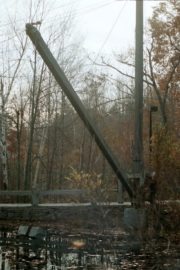Granite: The Product and the People
The 19th century granite industry provided jobs for men on the islands as well as on the mainland. The Wiscasset, now historic, jail was completed in 1811 with granite walls from the Edgecomb quarries. As early as 1832 many rooms, walls and arches of Fort Knox in Prospect were built of Maine granite. The product was often shipped out of state for buildings as far as Massachusetts, Philadelphia and Washington DC.
The Workers
Men from Scotland, Finland, Sweden and elsewhere came to America to work the quarries. In the late 19th and early 20th centuries, granite workers became organized, about the time that industrial unions emerged in the United States. The Lewiston Granite Cutters Union was organized in 1890. 1897 saw a local Granite Cutters Union formed in Calais. In 1902 the Mount Waldo Branch of the Granite Cutters Union in Frankfort was formed.
In the late 19th and early 20th centuries, granite quarries provided Waldoboro with a prosperous economic base. A branch of the Granite Cutters’ Union was established in 1899; the Quarrymen’s Protective Union followed in 1902.
Joseph R. Bodwell was certainly “in the right place at the right time,” since the demand for granite for buildings, bridges and pavement was booming. In 1866 he and another partner opened the Hallowell quarries, where the stone was lighter, easily worked, and more suitable to commercial buildings. He served as Maine’s governor in 1887 for a short period before his death in office.
The Quarries
Quarries could be found on the mainland in Addison, Albany, Alfred, Augusta, Baileyville, Hallowell, Harpswell, Stonington and many more. In the quarries developed along the coast of Maine, granite was found up to five miles deep. In Sullivan, sections of the granite are more than 420 million years old.
In the late the 19th century a granite quarry operated on Davis Mountain and another near Onawa Station and Greenwood Pond in Willimantic. Since 1926 Bailey Island in Harpswell has been connected to Orrs Island by the locally known granite “Cribstone Bridge.
Frankfort Granite cutting and shipping was an important industry up to the early 20th century. In that town Mount Waldo supplied the product and Marsh Bay, in the Penobscot River, provided the means of shipping it. In Franklin, the Robertson Quarry Galamander is on display. This four-wheeled, horse or oxen drawn wooden vehicle approximately 18 feet long and 6 feet wide. It is still in a public park at the junction of Route 182 and the Old Road under an open, roofed shelter.
Granite quarrying in the Town of Franklin is thought to have begun in the mid-19th century. However, large-scale operations do not seem to have developed until the late 1870s. Off-shore islands of Chebeague, Vinalhaven, Crotch Island (near Stonington), small Dix Island (in Muscle Ridge Channel) southwest of Vinalhaven, among others.
The Destinations
Maine
Acadia National Park bridges, abutments for bridges, Augusta Post office from granite in nearby Hallowell, St Marks Episcopal Church in Augusta; St. Mary’s Catholic Church in Augusta. Hallowell granite façade built the Bangor Adams-Pickering Block.
![Farmington Public Library [2003]](https://maineanencyclopedia.com/wp-content/uploads/03071117-Copy-280x194.jpg)
Farmington Public Library [2003]
Farmington’s historic Cutler Memorial Library is an unusual design and plan for a small early 20th century library. The library was built, in the Beaux-Arts classical style with granite from North Jay between 1901 and 1903.
Beyond Maine
Blue Hill granite quarrying for export began in 1816; in 1836 eighteen large cargoes were shipped for use in construction at Charlestown Navy Yard in Massachusetts.
Chebeague Island, settled in the 1760’s, became a center for granite transportation with its “stone sloops” in the late 1800s.
Starting in the 1850’s, granite quarried at Dix Island was shipped by sea to Washington, DC and was used for facings and columns in the Treasury Building. The New York and Philadelphia post offices were also built with granite from the island.


![Granite moving mechanism in Augusta (2002) [See crane below right]](https://maineanencyclopedia.com/wp-content/uploads/02110116-Copy.jpg)
